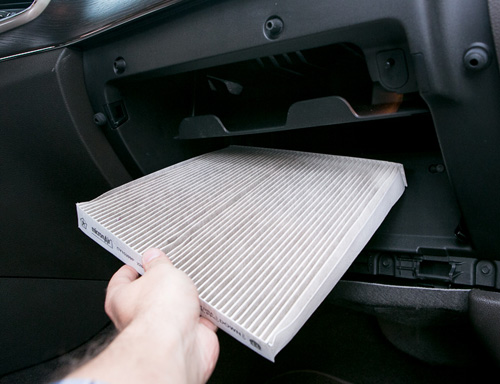Our air conditioning system includes an air purifier or cabin air filter. Unfortunately, many car owners don’t know this. Cabin filters have different materials, technology, specifications and size, depending on car models. Many cars are running with clogged and dirty cabin filters. This will result in degraded heating and cooling performance. The internal air quality also suffers when the filter isn’t serviced properly. Dust, twigs, leaves and other particles can easily clog the filter media. After 12,000 miles; the clean filter can turn into an ugly black thing.
A filter is typically found on newer car, built in 2000 or later. The owner’s manual should cover the replacement procedures. Unfortunately, these manuals can be cryptic at best for common car users. We should check with the local mechanic to know whether our car has cabin filter. Replacement may cost anywhere between $50 and $150, depending on the car model. Some cars may specify that cabin filter is an optional item, so it is important to consider whether we really need to use it. Filter manufacturers often have a list of compatible cars base based on the year, model and make.
Depending on the car model, cabin filters can be located in difference spots. As an example, cabin filter can be found inside the cab, under the hood or behind the access panel. Filters may also be located under the cowl. The cowl itself is the outer metal trim with windshield wipers and vent louvers sticking through it. In some models, we need to remove the cowl completely to access the cabin filter. There are different types of cabin air for cars. Single stage filters are useful for trapping big allergens like pollen, large soot particles and bigger airborne particles. More expensive models may have fiber mat with electrostatic charge that can better retain airborne particles. While they are not as effective as HEPA air filters, these filters are obviously better than filters with standard paper media.
The largest cabin filter size should be about 10 micron, but its effectiveness could drop rapidly when dealing with particles smaller than 3 microns. High-quality filters have one micron filters, but it won’t be able to prevent sub-micron molecules from passing through. It means that dangerous gas could still penetrate into the cabin. Common one-stage filter has limp media with no stiff edges. It means that the filter isn’t attached firmly in the plenum chamber or duct. It means that dirty air can seep into the gaps, making the filter less effective. Alternatively, we could also use multi-layer cabin filter that uses activated carbon to reduce exposure to odors and toxic gases. In fact, it is shown that the level of carbon monoxide can be reduced inside the cabin when we use multi-stage filters.
The service life of the filter is determined by the driving conditions. Desert dust and urban pollution will require us to make more frequent changes. The filter needs to be replaced when the performance of heater, defroster and air conditioned has fallen below the specified standard.

